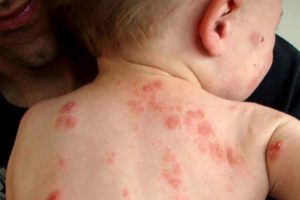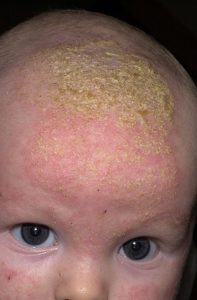Baby Rash Remedies
WE ALL WANT OUR BABIES TO BE SMILING AND HAPPY.
BUT HAVE YOU JUST NOTICED A BABY RASH ON YOUR BABY’S SKIN?
READ ON TO FIND OUT WHAT COULD BE CAUSING THE THREE MOST COMMON TYPES OF BABY RASH AND HOW YOU CAN TREAT THEM SAFELY.
Baby rash and other skin conditions are actually quite common in babies and newborns.
The good news is that if you discover your child has a baby rash then there are some simple things you can do to help minimise and relieve the condition.
The other good news is that these types of baby rashes generally won’t cause any long term problems if you treat them properly.
There are many types of Baby Rash caused by things such such as heat, meningitis, strep, chicken pox, hives, and allergies, stings, bites, viruses and other infections just to name a few. Each type of baby rash skin condition presents with a number of different symptoms. They can often change the appearance of the skin and some can cause discomfort to your baby.
Whilst most baby rashes are not serious and can be treated quite easily, it is important that you get the right advice because there are some rashes and skin conditions that can:
- be contagious and transmitted to someone else in your family or friends
- get worse very quickly without the correct treatment
- be very serious and need urgent attention
- easily affect and have more serious consequences
In this article we will be looking at the three most common kinds of baby rash which are; Nappy Rash, Cradle Cap, and Eczema.
Nappy Rash
Signs, symptoms and solutions
There is a reddening of the skin in the obvious “nappy area”. The skin itself may look raw or spotty, and is likely to be sore or itchy. It may even feel hot to the touch. We’re not going to share any pictures of this baby rash!
Nappy rash is a very common baby rash skin condition that happens to around one third of nappy wearing babies in the first 18 months. Nappy rash is caused when the skin comes into contact with urine and poo in the nappy for long periods of time. Mild cases are usually painless but severe nappy rash can cause extreme discomfort and distress to babies.
I clearly remember one of our first vacations at Christmas time with our then 8 month old daughter who got a bad case of nappy rash. Let’s just say that it was not a pleasant experience for any of us.
There are special creams known as ‘barrier’ creams (such as products containing zinc cream, zinc oxide ointment and petroleum jelly) that you can get specifically for nappy rash, just ask your child health nurse or pharmacist to recommend one. Essentially – as the name suggests – the cream creates a barrier on the skin so that urine and poo doesn’t come into contact wiht the skin.
If the rash doesn’t go away or your baby develops a persistent bright red, moist rash with white or red pimples, or pus, which spreads to the folds of the skin, they may also have an infection. You’ll need to use an anti-fungal cream that you can get from your pharmacist or doctor.
Here’s a few more handy hints and tips to help reduce the severity and time of this baby rash condition.
- try to keep the area dry by removing wet nappies as soon as practical and leaving your child out of nappies as much as possible.
- when you have to put nappies on, ensure the skin is dry first.
- when drying the babies skin, be extra gentle. Use soft cotton balls or a hand towel/flannel and dab the area gently. Don’t use baby wipes.
- if the odor of the nappy area permits, it may be preferably to only use warm water to clean the rash area until it is gone.
- however, if you feel like you need to ‘clean’ the area then try not to use any regular commercial soaps, or any products with chemicals or man made perfumes as these are known to irritate sensitive skin. Soaps made from Goats Milk and Shea butter designed for kids not only clean the area, but also helps nourish the rash.
- check your nappy brand and consider changing to one that is more absorbent.
- if using cloth nappies, make sure they are rinsed thoroughly. Don’t use ANY laundry liquids that contain chemicals in them. Consider using a 100% natural products such as those offered by the KidsBliss Laundry Care Range as they don’t leave nasty chemical reside in the nappies. Dry the nappies in direct sunlight, rather than in a clothes dryer.
- if using cloth nappies, you might even consider changing to disposable nappies for a while because these are able to keep the wetness away from the baby’s skin more effectively than cloth nappies.
- avoid tight-fitting, plastic over-pants because these make the area warm and moist, which is ideal for fungal growth
Please ensure you see a doctor if nappy rash doesn’t clear up quickly (e.g. in 1–2 weeks) with regular treatment, or if your baby seems unwell or upset.
Cradle cap
Signs, symptoms and solutions
Cradle cap is a greasy, yellowish, scaly rash that appears in patches on the scalps of young infants.
(image source https://mommyhood101.com/cradle-cap-pictures)
The affected skin can also appear red in colour, flaky and a yellowish crust might also form. There can be some hair loss when the affected areas of skin loosen.
It’s a common and harmless condition that affects about 30% of children within the first 3 months of life. Cradle cap doesn’t really cause discomfort to the baby. There is no known cause of cradle cap.
Cradle Cap is not contagious, and is a bit like dandruff. It just looks bad!
It often lasts for a few months and usually clears up by the time the baby is two years old.
Cradle cap usually doesn’t really need treatment. It should clear up on its own after a few months, but if it doesn’t, and you’re feeling a bit bothered by it then see your doctor, they may be able to prescribe something to help speed up the recovery.
KidsBliss ACO Baby Shampoo and KidsBliss ACO Baby Bath and Shampoo 2 in 1 can be used on children with cradle cap to help moisturise the scalp which may assist in a faster more comfortable recovery period due to the nourishing affect of the natural and organic ingredients.
We do not recommend using any shampoos or body care products containing chemicals in them as some of them have been known to potentially further dry the scalp.
Eczema
Signs, symptoms and solutions
Eczema is a chronic skin condition that usually begins in early childhood. Interestingly, If other family members are susceptible to asthma and hay-fever, then new members of that family appear to have a higher chance of presenting with eczema (ref emedicehealth.com.)
There are many different kinds of eczema, and the most well known type is called atopic dermatitis.

Eczema generally presents as patches of dry red flaky skin. 1 in 4 children will experience eczema before the age of 2*1. (*1 source and image from http://www.abc.net.au/news/2011-09-07/eczema-on-the-rise-in-australia/2874462)
The actual cause of eczema is not fully understood. It does appear to be hereditary, and may have something to do with proteins in the skin. Other common traits for people with eczema include hyper-reactivity to wool, itching during sweating, colonization by pathogenic staph bacteria, predisposition to disseminated herpes simplex infections, and a variety of immunologic abnormalities
Furthermore, babies who experience eczema in their infancy are more likely to develop other atopic skin disorders, allergies and even asthma, compared to babies who don’t experience eczema.
One of the most established ways to treat eczema is to keep the skin moisturised. We always recommend using products without any chemicals, and ones that are designed to soak into and nourish the skin without feeling greasy. Our top recommendation is of course our KidsBliss Baby Moisturiser which is an Australian Certified Organic product wiht the purest natural ingredients. Use i generously to keep the skin moisturised until the condition is under control.
So there you have it.
The three most common types of Baby Rash and how to easily treat them.
Please remember, if your child’s baby rash does not go away after a reasonable time and they are showing signs of distress, please see your medical practitioner for professional medical advice.


